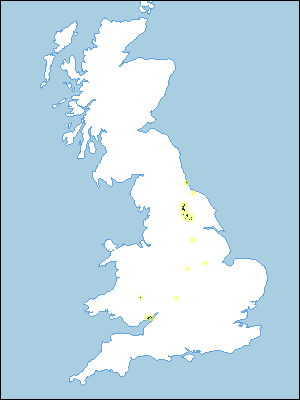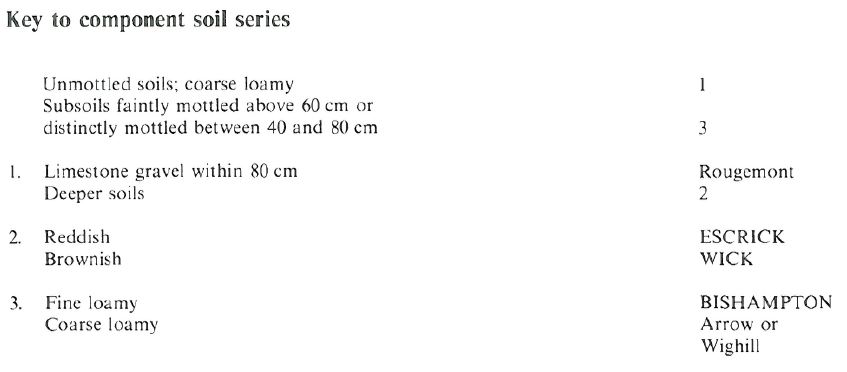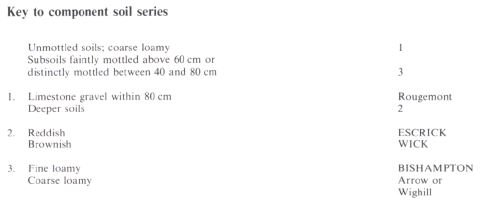
Soil Associations
0571q ESCRICK 2
Soil and site characteristics
Deep well drained often reddish coarse loamy soils. Some fine loamy soils with slowly permeable subsoils and slight seasonal waterlogging. Hummocky relief.
Geology
Glaciofluvial drift
Cropping and Land Use
Cereals, potatoes and sugar beet; some permanent grassland.
Component soil series
| Subgroup | Series name | Percentage | WRB 2006 link |
|---|---|---|---|
| 5.71 | ESCRICK | 60% | Chromic Luvisols |
| 5.72 | BISHAMPTON | 20% | Endostagnic Luvisols |
| 5.41 | WICK | 20% | Eutric Cambisols |
Covers 191 km2 in England and Wales
Soilscapes Classification
| 6 |
Freely draining slightly acid loamy soils |
0571q ESCRICK 2
Detailed Description
The association consists of coarse and fine loamy brown soils developed in glaciofluvial drift. It has been mapped mainly in Yorkshire but is also found in Wales and inextensively in Lincolnshire and Durham. It occurs mainly on gently undulating outwash plains, on moraines with slopes up to 7 degrees and occasionally on steeper land. The main soils are coarse loamy typical argillic brown earths, Escrick series, occupying approximately half the area. The Bishampton series, fine loamy stagnogleyic argillic brown earths, and the Wick series, typical brown earths, each occupy about one-fifth. The Escrick and Wick series are generally found on the upper slopes of moraines, with the less well drained Bishampton soils on the gentler and lower slopes. The association occurs on moraines north of the Caldicot Levels, between Newport and Chepstow. Escrick and Wick soils are dominant but the drift is variable in thickness and scattered knolls occur, associated with shallower soils - mainly brown earths - but with some brown rankers and brown rendzinas where limestone is near the surface. Rougemont and Wighill are rare. A small area (less than 1 km2) on a hilltop north-north-east of Chipping Campden has been included within the Escrick association.
The association occurs mainly between York and Leeming over 124 km², but occupies very small areas at Easington, in Durham and Tickhill, in South Yorkshire. It is mapped with the Bishampton association on the moraine running from Escrick to west of Wetherby. Rougemont soils are found in gravelly drift on some moraine crests around Wilberfoss. Wighill and Arrow soils occur around Thirsk where coarser material overlies the till to more than 40 cm depth.
Soil Water Regime
The dominant Escrick and Wick series are well drained (Wetness Class I) and readily absorb winter rainwater. The Bishampton series has a less permeable subsoil and is occasionally waterlogged (Wetness Class II). With a moisture deficit of more than 75 mm, potatoes benefit from irrigation.
Cropping and Land Use
The land is used mainly for dairying with some arable cropping, mainly of cereals, and long-term pasture. There are usually enough days in spring for cultivation although the soils remain drier for longer in autumn after harvesting cereals.
In the North of England most of the land is cultivated, with cereals, potatoes, sugar beet and some short leys, although there is some permanent grassland. Stoniness obstructs cultivation in places, especially where the Rougemont series occurs. The soils are easily worked but, under intensive use, heavy machinery such as that used in beet harvesting tends to compact surface and sub-surface horizons. This can be alleviated by deep subsoiling. In addition, under intensive cropping the soil structure tends to become less stable and surface capping occurs. The soils are rarely poached however. Autumn ploughing is not essential but timeliness is important. The topsoil is often slightly acid and liming is needed at regular intervals.
0571q ESCRICK 2
Distribution Map
 |
Note that the yellow shading represents a buffer to highlight the location of very small areas of the association.
Keys to component soil series
Midlands
 |
Northern Region
 |
Wales
 |
All information Copyright, Cranfield University © 2024
Citation: To use information from this web resource in your work, please cite this as follows:
Cranfield University 2024. The Soils Guide. Available: www.landis.org.uk. Cranfield University, UK. Last accessed 25/04/2024
